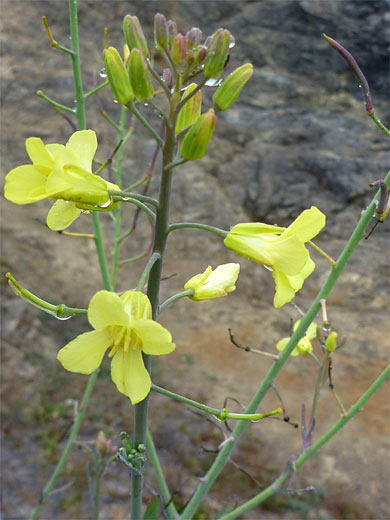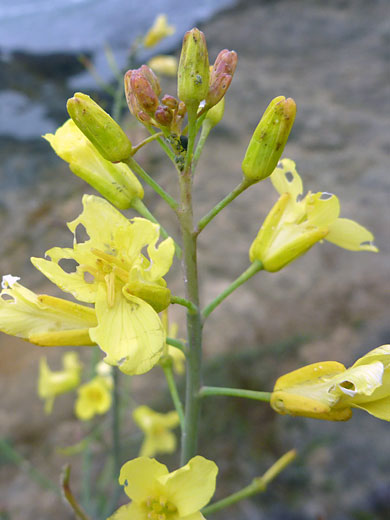Common name:
Wild cabbage
Family:
Scientific name:
Brassica oleracea
Main flower color:
Range:
Small areas of the Pacific states, mostly coastal, plus a few places to the east (non native)
Height:
Up to 3 feet
Habitat:
Fields, waste ground, coastal cliffs; sea level to 300 feet
Leaves:
Thick, toothed or lobed, oblong, ovate or lanceolate in shape, up to 15 inches long
Season:
May to August
Brassica oleracea is a European species which has become established in small parts of some of the Western states, and is most often found along the coast of California, reflecting the plant's high salt tolerance. Cultivated varieties include such staple vegetables as broccoli, sprouts, cauliflower and cabbage.
Flowers are typical of the mustard family, formed of four yellow, clawed petals, up to one inch in length, with rounded tips, and four greenish-yellow sepals, about half as long. At the center are four yellow stamens, which have relatively short filaments and long anthers. Flowers are arranged in an unbranched, elongated cluster.
The greyish-green stems are stout, smooth and hairless. The fleshy leaves are similarly colored, withering to purple; those around the base are borne on stalks of up to 10 inches while those on the stem are sessile, and heart-shaped at the base. Basal leaves are lined by large teeth or lobes.
Flowers are typical of the mustard family, formed of four yellow, clawed petals, up to one inch in length, with rounded tips, and four greenish-yellow sepals, about half as long. At the center are four yellow stamens, which have relatively short filaments and long anthers. Flowers are arranged in an unbranched, elongated cluster.
The greyish-green stems are stout, smooth and hairless. The fleshy leaves are similarly colored, withering to purple; those around the base are borne on stalks of up to 10 inches while those on the stem are sessile, and heart-shaped at the base. Basal leaves are lined by large teeth or lobes.
All Contents © Copyright The American Southwest | Comments and Questions | Contribute | Site Map





